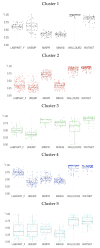Socioeconomic Urban Environment in Latin America: Towards a Typology of Cities
- PMID: 39898959
- PMCID: PMC7617124
- DOI: 10.3390/su15086380
Socioeconomic Urban Environment in Latin America: Towards a Typology of Cities
Abstract
This paper aims to identify typologies of Latin American cities based on socioeconomic urban environment patterns. We used census data from 371 urban agglomerations in 11 countries included in the SALURBAL project to identify socioeconomic typologies of cities in Latin America. Exploratory factor analysis was used to select a set of variables, and finite mixture modelling (FMM) was applied to identify clusters to define the typology of cities. Despite the heterogeneities among the Latin American cities, we also found similarities. By exploring intersections and contrasts among these clusters, it was possible to define five socioeconomic regional typology patterns. The main features of each one are low-education cities in Northeast Brazil; low-unemployment cities in Peru and Panama; high-education cities in Argentina, Chile, Colombia, Costa Rica, Nicaragua and Mexico; high female labor participation, with high primary education in Argentina and low primary education in Brazil; and low female labor participation and low education in Brazil, Colombia, El Salvador, Guatemala, and Mexico. Identifying clusters of cities with similar features underscores understanding of the urban social and economic development dynamics and assists in studying how urban features affect health, the environment, and sustainability.
Keywords: Latin America; finite mixture models; socioeconomic typology of cities.
Conflict of interest statement
Conflicts of Interest: The authors declare no conflict of interest. The funders had no role in the design of the study; in the collection, analyses, or interpretation of data; in the writing of the manuscript; or in the decision to publish the results.
Figures



References
-
- Brenner N. Towards a Critical Geography; Oxford University Press; Oxford, UK: 2004. Spaces of Capital.
-
- Mitchell D. The Right to the City: Social Justice and the Fight for Public Space; Guilford Press; New York, NY, USA: 2003.
-
- Brenner N. New State Spaces: Urban Governance and the Rescaling of Statehood; Oxford University Press; Oxford, NY, USA: 2004.
-
- MacLeod G, Jones M. Renewing Urban Politics. Urban Stud. 2011;48:2443–2472. doi: 10.1177/0042098011415717. - DOI
-
- Latham A. Urbanity, Lifestyle and Making Sense of the New Urban Cultural Economy: Notes from Auckland, New Zealand. Urban Stud. 2003;40:1699–1724. doi: 10.1080/0042098032000106564. - DOI
Grants and funding
LinkOut - more resources
Full Text Sources
